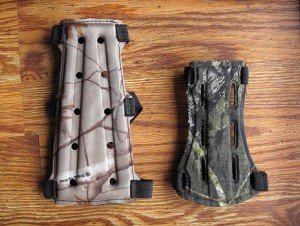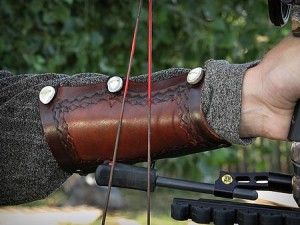The Archery Armguard
Oh, the all important armguard. With so many exciting archery accessories to choose from, the armguard is often overlooked. In fact some advanced archers don’t even wear one. But for the beginner archer, the armguard is absolutely necessary.
Why? Because it’s just a matter of time before you hit your forearm with the string and break all the blood vessels in a three-inch swathe. It’ll take a couple days for the swelling to go down, but the bruise will linger for a week.
What is an Armguard?
An armguards is a stiff piece of material worn on the inside of your bow arm, somewhere between your elbow and wrist. It should be worn snug enough to not slip around.
Armguards come in all shapes, sizes, and materials and attach around your arm with straps, buckles, Velcro, or string. In ancient times they were fashioned out of leather. Nowadays, it’s mostly stiff plastics, fabric, and cushioned material. You could even fashion one out of duct tape if you were so inclined. What’s important is you have something to protect your arm.

I prefer the Tarantula 3-Strap Armguard because it’s longer than the two-strap and therefore covers more of my sleeve.
Why Do I Need an Armguard?
The main reason is to protect your forearm and wrist from the bowstring. Perhaps just as importantly, it keeps bulky clothing out of string’s path, something to remember while hunting in cold weather. If the string contacts anything during the shot, the arrow will be thrown way off trajectory.
Another good reason to wear an armguard is to avoid developing target panic. “Target panic” is simply flinching during the shot. A very painful slap will often cause newbie archers to flinch at future shots, thus losing focus on the target. (The goal of archery is to shoot with a “surprise release,” while maintaining focus on the target, not the bow). Consequently, he’ll jerk the string loose instead of releasing smoothly. Releasing the arrow should be the result of your back muscles squeezing together, rather than punching the release or “plucking the string.” A bad case of target panic can take months to cure!
What Causes String Slap?
Hitting your arm with the string is easily avoided by holding the bow correctly. Remember to hold the bow with your elbow bent slightly outward. Don’t lock your elbow inward– a common newbie mistake. At the same time, don’t bend your elbow too much or your arm will fatigue out. A slight bend outward is all you need.
If you still have problems with string slap, it’s likely caused by two other factors:
- Short brace height. Brace height is the distance between the bowstring and the bow grip when the bow is at rest. Most bows are somewhere between six and eight inches. If the string is too long for your bow (traditional bows only), then you’ll have a short brace height. Upon release, the bow will pull the string into your wrist. You can easily remedy this by getting a slightly shorter string.
- Over-gripping your bow. This happens when you rotate your wrist too far around the bow grip, allowing bow settle in the center of your hand rather than your palm. Remember, the bow should settle at the base of your palm and in-line with your forearm. Over-gripping pulls your wrist into the bowstring’s path.
So much for the basics! I’ve touched on a lot of information here, but in the end just remember to wear an armguard. With enough practice and use of proper form, you won’t even have to wear one.
P.S., of course you can avoid string slap altogether if you aren’t bow hunting! If you are thinking about drawing for any rifle hunts, check out these rifle picks for specific game.

